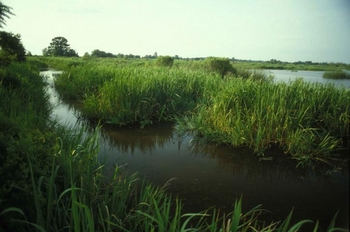-- Wholesale Only --
Wholesale customers please call for Plant availability list
*Pricing subject to change without notice*
Hours 8 - 4:30 Monday - Friday
Potted Plants only available by will call or delivered on our trucks
Filter the Pond with a Bog Garden

A bog is an area that consistently has a water level several inches below the “soil” surface. In nature, bog soils are usually very high in organic materials and low in pH. Traditionally, using semi-permeable liners, ornamental bog gardens have imitated these conditions in order to grow plants that have adapted to these areas, such as pitcher plants.
For filtration purposes, bog filter gardens are constructed using waterproof pond liner and pea gravel. They may utilize a wide range of marginal pond plants, bog plants, and even many terrestrial garden plants.
These bog filter gardens have two primary functions: beauty and filtration. The bog filter provides a perfect background for the pond, showcasing plants while allowing more pond surface area to remain open. It also provides a natural looking transition from land to pond, and enhances the landscaping around the pond. Bog gardens are the ultimate pond filter for water purity, clarity, and low maintenance. Unlike man made filters, bogs can completely process organic waste, including solid waste, and even process some inorganic waste, such as minerals. Man made filters merely mechanically trap debris and some biologically detoxify waste. Waste by-products still build up in the water and create various problems, including a build-up of nitrates and phosphates that promote algae growth. In a bog filter, gravel traps organic debris until it can be broken down by bacteria and used by plants. By-products are processed and used as food by microbes and plants.
Ponds with bog filters usually experience no algae blooms, even when brand new, and those that do quickly balance themselves. Bog filters are also extremely economical to build and maintain, and are compatible with other filtration systems if you desire them. Once you’ve used a bog filter, you won’t ever want a pond without one.
Typical Bog Filter Construction:
1) The size of bog filter required varies according to the organic load it is expected to process, often a function of how much fish food is used. For most purposes, a bog filter whose surface area is 10% of the surface area of the main pond will suffice, with up to 20% or more for heavy loads. Intense sunlight and high temperatures stimulate algae growth and so require higher performing bog filters, while lower temperatures and light levels reduce demand. Shape is more of an aesthetic function, dependent on each pond’s landscaping. Bog filters are often placed opposite from where people usually view the pond--they provide a beautiful background for the pond, and can wrap around several sides if desired.
2) Excavate an area next to the main pond to a depth of 12-14". Shallower bog filters provide less filtering area and heat up quickly, while deeper ones tend to create too many anaerobic low-flow zones (a certain amount of anaerobic activity is normal and even beneficial, but too much can produce toxic quantities of by-products). Build a retaining wall of concrete or concrete blocks to separate this area from the main pond. The top of the wall should be 1-2" below the pond surface when filled. Remember to make the wall for the bog filter level, and to allow extra liner for the sides of the retaining wall. Use felt protection mat and/or scrap liner to protect the liner from rough or sharp edges. Fill in any large cracks deeper than 2" below pond surface which would “leak out” gravel, using mortar or black expanding foam. An alternate filter placement is to build the bog as an extra-wide shelf, place the liner, and build the retaining wall on top of the liner, using rock if desired. Another style is to retrofit one end or corner of the pond into a bog filter.
3) Place liner in pond and bog filter, following vendor’s liner installation instructions. Hide all liner after construction.
4) Install the pump in the pond as far away from the bog filter as possible, using a pump which circulates pond volume at least once every two hours for pond under 4,000 gallons, and at least once every four hours for ponds over 4,000 gallons (more is better). Use over-sized pipe or tubing to maximize flow to the bog -- 2” diameter is standard. Screen or pre-filter the pump enough to prevent clogging, but do not over-filter; let the bog filter trap and eat the detritus. Some people split and valve the output from one pump to operate both a waterfall and a bog filter, while others use two pumps. The waterfall can even empty into one end of a wrap-around bog filter, with water falling into the pond at the other end of the bog.
5) Use PVC pipe to build a distribution manifold the length of the bog. Drill 1/4" holes about 3" apart, in a line about halfway between the side and bottom of the pipe, or cut slots into the pipe (we prefer slots). Use an elbow at the end of all manifold lines, add a short piece of pipe to bring it to the bog surface, and glue a male adapter with a threaded cap on it for cleanout. Center the pipe along the bottom of the bog. Bogs wider than 3’ benefit from multiple lines set 12-18” apart.
6) Place decorative (usually flat) rock across the top of the retaining wall, allowing small cracks between and under rocks for water flow. Water will be pumped from the main pond into the bog filter, through the gravel, and flow back into the pond over the retaining wall through cracks between rocks.
7) Fill bog filter with 3/8” diameter rounded (pea) gravel, mounding the gravel so it is 2” to 3" above water level for most of the bog. Having gravel above the water surface is important because water will follow the path of least resistance; if allowed to go over the gravel, water will bypass most of the gravel, bacteria and plant roots doing the filtering. Using smaller or crushed gravel or sand restricts water flow and clogs too easily. Using larger diameter gravel or rock is less hospitable for plant roots, and provides insufficient surface area for colonizing bacteria. It’s all right to mix larger pieces of river rock into the top layer of gravel for a more natural look. Incorporate some of the rock that is around the pond and landscape in the bog filter as well, to visually tie the landscaping together. Feel free to use some large pieces of wood or other decoration in the bog. While all this decoration is likely to be covered by plant material soon, it looks more natural in the meantime, and the filter will be exposed from time to time after harvesting or during winter dormancy.
8) Plant the bog filter, using any moisture loving plants. Your choices will be dictated by climate to a certain extent, unless you are willing to sacrifice or repot and bring in tender species. Different plants obviously thrive in different climates.
We emphasize using two plant categories for greatest efficiency:
- tall
plants with persistent (year round) fibrous roots such as various rushes,
Thalia, Irises including Iris versicolor, and cannas--their fibrous roots
provide excellent colonization sites for beneficial microbes in both
summer and winter. Gunnera and Thalia make great focal points. Other tall plants
include cattails, pickerel,
Louisiana iris, lizard’s tail, ribbon grass, horsetail, hostas, and daylilies. - short “ground cover” plants around the bog edge and among the tall plants. Excellent fast growing ground covers include parrot’s feather, creeping Jenny, variegated or green water celery (edible!), and aquatic mint (edible!). Shade loving plants such as aquatic forget-me-not and watercress can find homes in a bog filter. These fast growers provide the bulk of the nutrient absorption, and soften the transition between pond and land; in fact, they will probably grow out into the soil bordering the bog. Use only a few varieties to minimize an untidy look.
Remember, bog filter plants have their roots in the water but their crowns above water, plus the water is fresh and highly oxygenated. This means you can use plants that are not usually considered aquatic, such as impatiens. Most ferns are also moisture-loving. Now may be the time to experiment with hydroponics tomatoes!
When planting the bog filter, do not strip the soil away from the plant’s root ball. Instead, gently remove the plant from the pot, and plant the entire root ball in the gravel, soil and all (but definitely without the pot!). This small amount of soil will not harm the pond or filter, and will help the plant quickly adjust to its new home.
To achieve a full effect, use up to one plant per square foot of bog filter surface; or use as few as one plant per three square feet and let time do the rest. Fewer plants means reduced filtration until they grow and fill in.
9) For faster cycling of nutrients, inoculate the pond with a pond bacterial culture. This can help with a new pond, or if the pond accumulates organic debris quickly. While occasional bacterial inoculation may be useful with heavy organic loads (overcrowding and overfeeding fish ponds is the #1culprit), it is not normally needed.
10) Little maintenance is required, other than harvesting excess plant material and some trimming of dead foliage in the fall. Trim and divide plants as needed. When plants are overcrowded, they can’t do their job--their growth slows, and they are not pulling as many nutrients from the water. Groundcover plants grow especially quickly. Pulling plants out of gravel is quick and easy, as is trimming. Don’t feel bad about harvesting them, as they make great compost, and your garden is a better place for the nutrients than your pond. Watercress is enjoyed by people and koi. With the right balance, sediment will build up very slowly, if at all. Every 5-10 years or so, a partial cleaning of the gravel may be required in areas where large amounts of inorganic debris are deposited, such as dry, windy climates where wind blows a lot of dust in.
There are many variations to this basic design. Existing ponds may be retrofitted with a bog filter by making the bog slightly higher than the main pond, and connecting bog and pond with a streambed or piping (they don’t even need to be close to one another!). Or make a bog in the corner of an existing pond, create a bog island, convert a waterfall filter, use oak barrels or ceramic pottery bog filters…you are limited only by your imagination.
Bog filters work incredibly well in promoting crystal clear water, and they exert a high degree of control over algae. Use and enjoy their beauty and simplicity.

